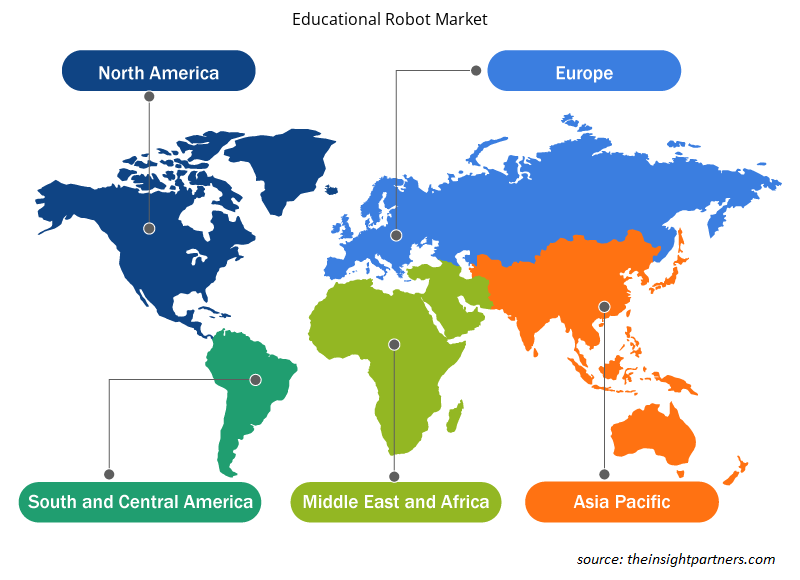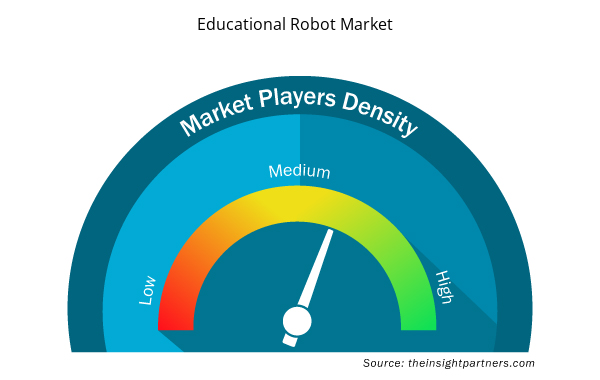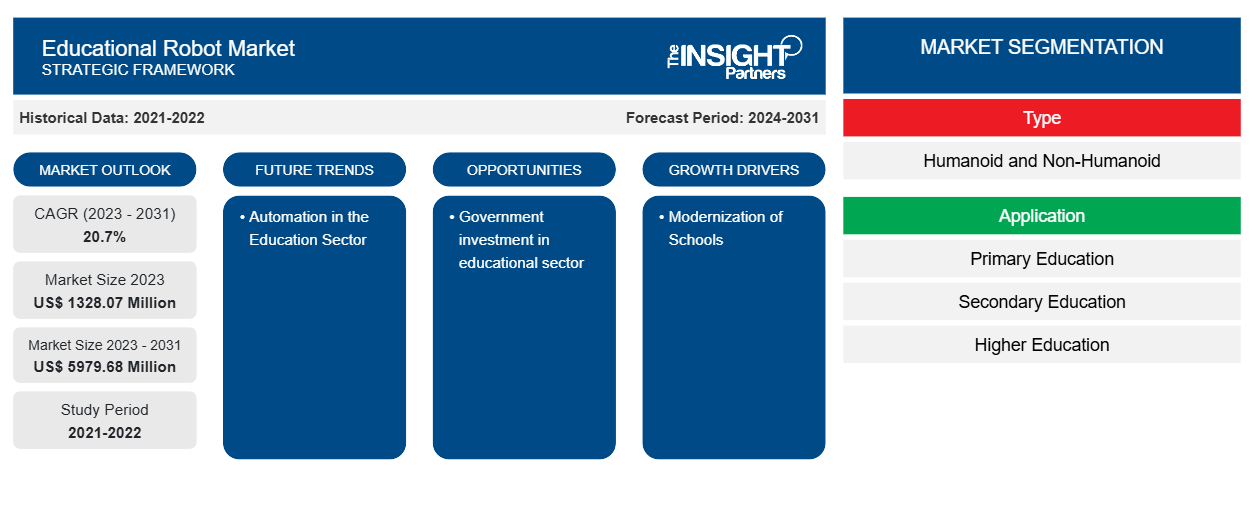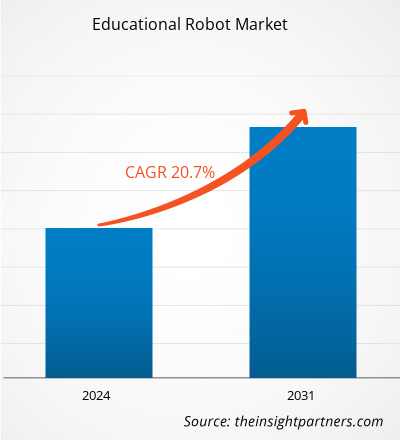Si prevede che il mercato dei robot educativi raggiungerà i 5979,68 milioni di dollari entro il 2031, rispetto ai 1328,07 milioni di dollari del 2023. Si prevede che il mercato registrerà un CAGR del 20,7% nel periodo 2023-2031. È probabile che gli investimenti governativi in robotica e automazione nel settore dell'istruzione rimangano tendenze chiave nel mercato.
Analisi del mercato dei robot educativi
La crescente attenzione al potenziamento di scienza, tecnologia, ingegneria e matematica (STEM) sta guidando la crescita del mercato. Gli investimenti nel sistema educativo da parte delle autorità governative promuovono ulteriormente la crescita del mercato. Scuole e college stanno includendo vari aspetti della robotica che spingono la crescita del mercato.
Panoramica del mercato dei robot educativi
I robot educativi sono robot programmabili che consentono agli studenti di tutte le età di approfondire la loro conoscenza della robotica e della programmazione. Inoltre, li aiutano ad apprendere altre competenze cognitive. Forniscono agli studenti tutto ciò di cui hanno bisogno per costruire e programmare un robot in grado di svolgere una varietà di compiti.
Personalizza questo report in base alle tue esigenze
Riceverai la personalizzazione gratuita di qualsiasi report, comprese parti di questo report, o analisi a livello nazionale, pacchetto dati Excel, oltre a usufruire di grandi offerte e sconti per start-up e università
- Scopri le principali tendenze di mercato in questo rapporto.Questo campione GRATUITO includerà analisi di dati che spaziano dalle tendenze di mercato alle stime e alle previsioni.
Driver e opportunità del mercato dei robot educativi
Modernizzazione delle scuole
Il governo sta investendo molto nel settore dell'istruzione per modernizzare scuole e college e migliorare ulteriormente l'apprendimento degli studenti. Questi investimenti stanno incoraggiando gli operatori del mercato a fornire i loro robot educativi nelle scuole, il che sta guidando la crescita del mercato. Ad esempio, nell'aprile 2022, la danese Shape Robotics ha affermato di aver firmato un accordo con la pari locale KUBO Robots per distribuire robot educativi alle scuole in Romania.
Automazione nel settore dell'istruzione
Il sondaggio globale del 2023 di ABB su 2.301 professionisti dell'istruzione ha scoperto che l'80 percento ritiene che robot e automazione plasmeranno il futuro dell'occupazione nei prossimi dieci anni. L'uso di robot nel sistema educativo e nei programmi di insegnamento. Gli attori del mercato dei robot industriali si concentrano sul lancio di robot nel settore dell'istruzione che possono alimentare il mercato dei robot educativi in futuro.
Analisi della segmentazione del rapporto di mercato dei robot educativi
I segmenti chiave che hanno contribuito alla derivazione dell'analisi di mercato dei robot educativi sono tipologia e applicazione.
- In base al tipo, il mercato dei robot educativi è segmentato in umanoidi e non umanoidi. Il segmento non umanoide ha detenuto la quota maggiore del mercato nel 2023.
- Per applicazione, il mercato è segmentato in istruzione primaria, istruzione secondaria, istruzione superiore e altri. L'altro segmento deteneva una quota significativa del mercato nel 2023.
Analisi della quota di mercato dei robot educativi per area geografica
L'ambito geografico del rapporto sul mercato dei robot educativi è suddiviso principalmente in cinque regioni: Nord America, Asia Pacifico, Europa, Medio Oriente e Africa, Sud e Centro America.
Si prevede che la regione Asia-Pacifico crescerà con il CAGR più elevato durante il periodo di previsione. La regione è focalizzata sul progresso tecnologico nel settore educativo. L'investimento crescente nel settore educativo integra la crescita del mercato. L'introduzione di robot nelle scuole guida ulteriormente la crescita del mercato nella regione. Ad esempio, a marzo 2024, una scuola del Kerala ha introdotto la prima insegnante di intelligenza artificiale del paese, Iris, per compiere un passo innovativo verso l'istruzione. Iris è stata creata in collaborazione con Makerlabs Edutech ed è la prima insegnante robot umanoide dello stato e probabilmente della nazione. Iris è in grado di rispondere a domande complesse su vari argomenti, offrendo supporto vocale personalizzato e promuovendo opportunità educative interattive. Inoltre, Iris è dotata di ruote per aumentare la mobilità.CAGR during the forecast period. The region is focused on technological advancement in the educational sector. The rising investment in the educational sector Kerala school introduced the country’s first AI Teacher, Iris to take an innovative step towards education. Iris was created in partnership with Makerlabs Edutech and is the state's and probably the nation's first humanoid robot teacher. Iris is capable of answering intricate queries across various subjects, offering individualized voice support, and promoting interactive educational opportunities. In addition, Iris is equipped with wheels to increase mobility.
Approfondimenti regionali sul mercato dei robot educativi
Le tendenze regionali e i fattori che influenzano il mercato dei robot educativi durante il periodo di previsione sono stati ampiamente spiegati dagli analisti di Insight Partners. Questa sezione discute anche i segmenti e la geografia del mercato dei robot educativi in Nord America, Europa, Asia Pacifico, Medio Oriente e Africa e America meridionale e centrale.

- Ottieni i dati specifici regionali per il mercato dei robot educativi
Ambito del rapporto sul mercato dei robot educativi
| Attributo del report | Dettagli |
|---|---|
| Dimensioni del mercato nel 2023 | 1328,07 milioni di dollari USA |
| Dimensioni del mercato entro il 2031 | 5979,68 milioni di dollari USA |
| CAGR globale (2023-2031) | 20,7% |
| Dati storici | 2021-2022 |
| Periodo di previsione | 2024-2031 |
| Segmenti coperti | Per tipo
|
| Regioni e Paesi coperti | America del Nord
|
| Leader di mercato e profili aziendali chiave |
|
Densità dei giocatori del mercato dei robot educativi: comprendere il suo impatto sulle dinamiche aziendali
Il mercato dei robot educativi sta crescendo rapidamente, spinto dalla crescente domanda degli utenti finali dovuta a fattori quali l'evoluzione delle preferenze dei consumatori, i progressi tecnologici e una maggiore consapevolezza dei vantaggi del prodotto. Con l'aumento della domanda, le aziende stanno ampliando le loro offerte, innovando per soddisfare le esigenze dei consumatori e capitalizzando sulle tendenze emergenti, il che alimenta ulteriormente la crescita del mercato.
La densità degli operatori di mercato si riferisce alla distribuzione di aziende o società che operano in un particolare mercato o settore. Indica quanti concorrenti (operatori di mercato) sono presenti in un dato spazio di mercato in relazione alle sue dimensioni o al valore di mercato totale.
Le principali aziende che operano nel mercato dei robot educativi sono:
- Robotica Aisoy
- Azienda: Hanson Robotics Limited
- Robotica modulare
- Robotica PAL
- Società americana FANUC
- Tecnologia di innovazione Sanbot Ltd
Disclaimer : le aziende elencate sopra non sono classificate secondo un ordine particolare.

- Ottieni una panoramica dei principali attori del mercato dei robot educativi
Notizie e sviluppi recenti sul mercato dei robot educativi
Il mercato dei robot educativi viene valutato raccogliendo dati qualitativi e quantitativi dopo la ricerca primaria e secondaria, che include importanti pubblicazioni aziendali, dati associativi e database. Di seguito sono elencati alcuni degli sviluppi nel mercato dei robot educativi:
- ABB Robotics ha ampliato la sua offerta formativa con il lancio dell'IRB 1090. Il robot didattico industriale 1090, autenticato dall'istituto di istruzione riconosciuto a livello mondiale STEM.org, è progettato per migliorare le competenze degli studenti e fornire loro un vantaggio competitivo nell'ottenere un impiego. Il nuovo robot didattico costituisce una parte fondamentale dell'offerta formativa più ampia di ABB, che include robot industriali aggiuntivi, nonché pacchetti di istruzione, controller di nuova generazione e software di programmazione e simulazione leader di mercato. (Fonte: ABB Robotics, comunicato stampa, settembre 2023)
- MatataStudio, un fornitore di soluzioni di apprendimento digitale con innovazione e originalità al centro, ha lanciato un nuovo kit di robot educativo chiamato "VinciBot", che mira a combinare informatica, intelligenza artificiale e istruzione in modo divertente. Concetti high-tech come (AI) e apprendimento automatico (ML) vengono introdotti nelle aule delle scuole primarie. Questi kit di robotica non sono solo altamente educativi, ma incorporano anche programmazione, pensiero computazionale, creatività ed esplorazione. Il concetto di design di MatataStudio è quello di incoraggiare i bambini a padroneggiare le conoscenze di base di programmazione e informatica costruendo e azionando robot con le proprie mani, coltivando al contempo il loro pensiero innovativo e le capacità di risoluzione dei problemi. (Fonte: MatataStudio, comunicato stampa, febbraio 2024)
Copertura e risultati del rapporto sul mercato dei robot educativi
Il rapporto "Dimensioni e previsioni del mercato dei robot educativi (2021-2031)" fornisce un'analisi dettagliata del mercato che copre le seguenti aree:
- Dimensioni e previsioni del mercato dei robot educativi a livello globale, regionale e nazionale per tutti i segmenti di mercato chiave coperti dall'ambito
- Tendenze del mercato dei robot educativi, nonché dinamiche di mercato come driver, vincoli e opportunità chiave
- Analisi dettagliata delle cinque forze PEST/Porter e SWOT
- Analisi di mercato dei robot educativi che copre le principali tendenze del mercato, il quadro globale e regionale, i principali attori, le normative e i recenti sviluppi del mercato
- Analisi del panorama industriale e della concorrenza che copre la concentrazione del mercato, l'analisi della mappa di calore, i principali attori e gli sviluppi recenti nel mercato dei robot educativi
- Profili aziendali dettagliati
- Analisi storica (2 anni), anno base, previsione (7 anni) con CAGR
- Analisi PEST e SWOT
- Valore/volume delle dimensioni del mercato - Globale, regionale, nazionale
- Industria e panorama competitivo
- Set di dati Excel



Report Coverage
Revenue forecast, Company Analysis, Industry landscape, Growth factors, and Trends

Segment Covered
This text is related
to segments covered.

Regional Scope
North America, Europe, Asia Pacific, Middle East & Africa, South & Central America

Country Scope
This text is related
to country scope.
Domande frequenti
The estimated value of the educational robot market will be US$ 5979.68 million by 2031.
Aisoy Robotics; Hanson Robotics Limited; Modular Robotics; PAL Robotics; FANUC America Corporation; Sanbot Innovation Technology Ltd.; Life & Science, Inc.; iRobot Education; Softbank Robotics Group Corp.; and Lego System A/S are some of the key players operating in the educational robot market.
The government investment in robotics and the need for cognitive skills in kids are the key driving factors impacting the educational robot market.
Automation in the education sector is considered a key trend in the online exam-proctoring market.
The global educational robot market is estimated to register a CAGR of 20.7% during the forecast period 2023–2031.
Trends and growth analysis reports related to Electronics and Semiconductor : READ MORE..
The Insight Partners performs research in 4 major stages: Data Collection & Secondary Research, Primary Research, Data Analysis and Data Triangulation & Final Review.
- Data Collection and Secondary Research:
As a market research and consulting firm operating from a decade, we have published and advised several client across the globe. First step for any study will start with an assessment of currently available data and insights from existing reports. Further, historical and current market information is collected from Investor Presentations, Annual Reports, SEC Filings, etc., and other information related to company’s performance and market positioning are gathered from Paid Databases (Factiva, Hoovers, and Reuters) and various other publications available in public domain.
Several associations trade associates, technical forums, institutes, societies and organization are accessed to gain technical as well as market related insights through their publications such as research papers, blogs and press releases related to the studies are referred to get cues about the market. Further, white papers, journals, magazines, and other news articles published in last 3 years are scrutinized and analyzed to understand the current market trends.
- Primary Research:
The primarily interview analysis comprise of data obtained from industry participants interview and answers to survey questions gathered by in-house primary team.
For primary research, interviews are conducted with industry experts/CEOs/Marketing Managers/VPs/Subject Matter Experts from both demand and supply side to get a 360-degree view of the market. The primary team conducts several interviews based on the complexity of the markets to understand the various market trends and dynamics which makes research more credible and precise.
A typical research interview fulfils the following functions:
- Provides first-hand information on the market size, market trends, growth trends, competitive landscape, and outlook
- Validates and strengthens in-house secondary research findings
- Develops the analysis team’s expertise and market understanding
Primary research involves email interactions and telephone interviews for each market, category, segment, and sub-segment across geographies. The participants who typically take part in such a process include, but are not limited to:
- Industry participants: VPs, business development managers, market intelligence managers and national sales managers
- Outside experts: Valuation experts, research analysts and key opinion leaders specializing in the electronics and semiconductor industry.
Below is the breakup of our primary respondents by company, designation, and region:

Once we receive the confirmation from primary research sources or primary respondents, we finalize the base year market estimation and forecast the data as per the macroeconomic and microeconomic factors assessed during data collection.
- Data Analysis:
Once data is validated through both secondary as well as primary respondents, we finalize the market estimations by hypothesis formulation and factor analysis at regional and country level.
- Macro-Economic Factor Analysis:
We analyse macroeconomic indicators such the gross domestic product (GDP), increase in the demand for goods and services across industries, technological advancement, regional economic growth, governmental policies, the influence of COVID-19, PEST analysis, and other aspects. This analysis aids in setting benchmarks for various nations/regions and approximating market splits. Additionally, the general trend of the aforementioned components aid in determining the market's development possibilities.
- Country Level Data:
Various factors that are especially aligned to the country are taken into account to determine the market size for a certain area and country, including the presence of vendors, such as headquarters and offices, the country's GDP, demand patterns, and industry growth. To comprehend the market dynamics for the nation, a number of growth variables, inhibitors, application areas, and current market trends are researched. The aforementioned elements aid in determining the country's overall market's growth potential.
- Company Profile:
The “Table of Contents” is formulated by listing and analyzing more than 25 - 30 companies operating in the market ecosystem across geographies. However, we profile only 10 companies as a standard practice in our syndicate reports. These 10 companies comprise leading, emerging, and regional players. Nonetheless, our analysis is not restricted to the 10 listed companies, we also analyze other companies present in the market to develop a holistic view and understand the prevailing trends. The “Company Profiles” section in the report covers key facts, business description, products & services, financial information, SWOT analysis, and key developments. The financial information presented is extracted from the annual reports and official documents of the publicly listed companies. Upon collecting the information for the sections of respective companies, we verify them via various primary sources and then compile the data in respective company profiles. The company level information helps us in deriving the base number as well as in forecasting the market size.
- Developing Base Number:
Aggregation of sales statistics (2020-2022) and macro-economic factor, and other secondary and primary research insights are utilized to arrive at base number and related market shares for 2022. The data gaps are identified in this step and relevant market data is analyzed, collected from paid primary interviews or databases. On finalizing the base year market size, forecasts are developed on the basis of macro-economic, industry and market growth factors and company level analysis.
- Data Triangulation and Final Review:
The market findings and base year market size calculations are validated from supply as well as demand side. Demand side validations are based on macro-economic factor analysis and benchmarks for respective regions and countries. In case of supply side validations, revenues of major companies are estimated (in case not available) based on industry benchmark, approximate number of employees, product portfolio, and primary interviews revenues are gathered. Further revenue from target product/service segment is assessed to avoid overshooting of market statistics. In case of heavy deviations between supply and demand side values, all thes steps are repeated to achieve synchronization.
We follow an iterative model, wherein we share our research findings with Subject Matter Experts (SME’s) and Key Opinion Leaders (KOLs) until consensus view of the market is not formulated – this model negates any drastic deviation in the opinions of experts. Only validated and universally acceptable research findings are quoted in our reports.
We have important check points that we use to validate our research findings – which we call – data triangulation, where we validate the information, we generate from secondary sources with primary interviews and then we re-validate with our internal data bases and Subject matter experts. This comprehensive model enables us to deliver high quality, reliable data in shortest possible time.


 Ottieni un campione gratuito per questo repot
Ottieni un campione gratuito per questo repot